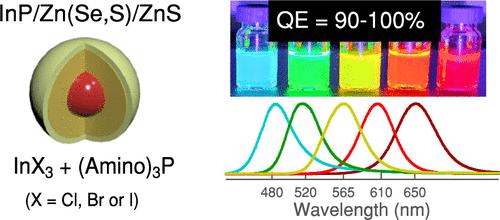Our official English website, www.x-mol.net, welcomes your
feedback! (Note: you will need to create a separate account there.)
Full-Spectrum InP-Based Quantum Dots with Near-Unity Photoluminescence Quantum Efficiency
ACS Nano ( IF 15.8 ) Pub Date : 2022-06-16 , DOI: 10.1021/acsnano.2c03138 Hannes Van Avermaet 1, 2 , Pieter Schiettecatte 1, 2 , Sandra Hinz 3, 4 , Luca Giordano 1, 2 , Fabio Ferrari 5 , Céline Nayral 5 , Fabien Delpech 5 , Janina Maultzsch 4 , Holger Lange 3 , Zeger Hens 1, 2
ACS Nano ( IF 15.8 ) Pub Date : 2022-06-16 , DOI: 10.1021/acsnano.2c03138 Hannes Van Avermaet 1, 2 , Pieter Schiettecatte 1, 2 , Sandra Hinz 3, 4 , Luca Giordano 1, 2 , Fabio Ferrari 5 , Céline Nayral 5 , Fabien Delpech 5 , Janina Maultzsch 4 , Holger Lange 3 , Zeger Hens 1, 2
Affiliation

|
Photoluminescent color conversion by quantum dots (QDs) makes possible the formation of spectrum-on-demand light sources by combining blue LEDs with the light generated by a specific blend of QDs. Such applications, however, require a near-unity photoluminescence quantum efficiency since self-absorption magnifies disproportionally the impact of photon losses on the overall conversion efficiency. Here, we present a synthesis protocol for forming InP-based QDs with +90% quantum efficiency across the full visible spectrum from blue/cyan to red. The central features of our approach are as follows: (1) the formation of InP core QDs through one-batch-one-size reactions based on aminophosphine as the phosphorus precursor, (2) the introduction of a core/shell/shell InP/Zn(Se,S)/ZnS structure, and (3) the use of specific interfacial treatments, most notably the saturation of the ZnSe surface with zinc acetate prior to ZnS shell growth. Moreover, we adapted the composition of the Zn(Se,S) inner shell to attain the intended emission color while minimizing line broadening induced by the InP/ZnS lattice mismatch. The protocol is established by analysis of the QD composition and structure using multiple techniques, including solid-state nuclear magnetic resonance spectroscopy and Raman spectroscopy, and verified for reproducibility by having different researchers execute the same protocol. The realization of full-spectrum, +90% quantum efficiency will strongly facilitate research into light–matter interaction in general and luminescent color conversion in particular through InP-based QDs.
中文翻译:

具有接近统一光致发光量子效率的全光谱 InP 基量子点
量子点 (QD) 的光致发光颜色转换通过将蓝色 LED 与特定混合 QD 产生的光相结合,使得按需光谱光源的形成成为可能。然而,此类应用需要接近统一的光致发光量子效率,因为自吸收不成比例地放大了光子损失对整体转换效率的影响。在这里,我们提出了一种合成协议,用于形成基于 InP 的量子点,在从蓝色/青色到红色的整个可见光谱范围内具有 +90% 的量子效率。我们方法的核心特征如下:(1)通过基于氨基膦作为磷前体的一批一次性反应形成 InP 核量子点,(2)引入核/壳/壳 InP/ Zn(Se,S)/ZnS 结构,以及 (3) 特定界面处理的使用,最值得注意的是在 ZnS 壳生长之前 ZnSe 表面被乙酸锌饱和。此外,我们调整了 Zn(Se,S) 内壳的组成以获得预期的发射颜色,同时最大限度地减少由 InP/ZnS 晶格失配引起的线展宽。该协议是通过使用多种技术分析 QD 成分和结构而建立的,包括固态核磁共振光谱和拉曼光谱,并通过让不同的研究人员执行相同的协议来验证可重复性。全光谱、+90% 量子效率的实现将极大地促进对一般光物质相互作用和发光颜色转换的研究,特别是通过基于 InP 的量子点。我们调整了 Zn(Se,S) 内壳的组成以获得预期的发射颜色,同时最大限度地减少由 InP/ZnS 晶格失配引起的线展宽。该协议是通过使用多种技术分析 QD 成分和结构而建立的,包括固态核磁共振光谱和拉曼光谱,并通过让不同的研究人员执行相同的协议来验证可重复性。全光谱、+90% 量子效率的实现将极大地促进对一般光物质相互作用和发光颜色转换的研究,特别是通过基于 InP 的量子点。我们调整了 Zn(Se,S) 内壳的组成以获得预期的发射颜色,同时最大限度地减少由 InP/ZnS 晶格失配引起的线展宽。该协议是通过使用多种技术分析 QD 成分和结构而建立的,包括固态核磁共振光谱和拉曼光谱,并通过让不同的研究人员执行相同的协议来验证可重复性。全光谱、+90% 量子效率的实现将极大地促进对一般光物质相互作用和发光颜色转换的研究,特别是通过基于 InP 的量子点。该协议是通过使用多种技术分析 QD 成分和结构而建立的,包括固态核磁共振光谱和拉曼光谱,并通过让不同的研究人员执行相同的协议来验证可重复性。全光谱、+90% 量子效率的实现将极大地促进对一般光物质相互作用和发光颜色转换的研究,特别是通过基于 InP 的量子点。该协议是通过使用多种技术分析 QD 成分和结构而建立的,包括固态核磁共振光谱和拉曼光谱,并通过让不同的研究人员执行相同的协议来验证可重复性。全光谱、+90% 量子效率的实现将极大地促进对一般光物质相互作用和发光颜色转换的研究,特别是通过基于 InP 的量子点。
更新日期:2022-06-16
中文翻译:

具有接近统一光致发光量子效率的全光谱 InP 基量子点
量子点 (QD) 的光致发光颜色转换通过将蓝色 LED 与特定混合 QD 产生的光相结合,使得按需光谱光源的形成成为可能。然而,此类应用需要接近统一的光致发光量子效率,因为自吸收不成比例地放大了光子损失对整体转换效率的影响。在这里,我们提出了一种合成协议,用于形成基于 InP 的量子点,在从蓝色/青色到红色的整个可见光谱范围内具有 +90% 的量子效率。我们方法的核心特征如下:(1)通过基于氨基膦作为磷前体的一批一次性反应形成 InP 核量子点,(2)引入核/壳/壳 InP/ Zn(Se,S)/ZnS 结构,以及 (3) 特定界面处理的使用,最值得注意的是在 ZnS 壳生长之前 ZnSe 表面被乙酸锌饱和。此外,我们调整了 Zn(Se,S) 内壳的组成以获得预期的发射颜色,同时最大限度地减少由 InP/ZnS 晶格失配引起的线展宽。该协议是通过使用多种技术分析 QD 成分和结构而建立的,包括固态核磁共振光谱和拉曼光谱,并通过让不同的研究人员执行相同的协议来验证可重复性。全光谱、+90% 量子效率的实现将极大地促进对一般光物质相互作用和发光颜色转换的研究,特别是通过基于 InP 的量子点。我们调整了 Zn(Se,S) 内壳的组成以获得预期的发射颜色,同时最大限度地减少由 InP/ZnS 晶格失配引起的线展宽。该协议是通过使用多种技术分析 QD 成分和结构而建立的,包括固态核磁共振光谱和拉曼光谱,并通过让不同的研究人员执行相同的协议来验证可重复性。全光谱、+90% 量子效率的实现将极大地促进对一般光物质相互作用和发光颜色转换的研究,特别是通过基于 InP 的量子点。我们调整了 Zn(Se,S) 内壳的组成以获得预期的发射颜色,同时最大限度地减少由 InP/ZnS 晶格失配引起的线展宽。该协议是通过使用多种技术分析 QD 成分和结构而建立的,包括固态核磁共振光谱和拉曼光谱,并通过让不同的研究人员执行相同的协议来验证可重复性。全光谱、+90% 量子效率的实现将极大地促进对一般光物质相互作用和发光颜色转换的研究,特别是通过基于 InP 的量子点。该协议是通过使用多种技术分析 QD 成分和结构而建立的,包括固态核磁共振光谱和拉曼光谱,并通过让不同的研究人员执行相同的协议来验证可重复性。全光谱、+90% 量子效率的实现将极大地促进对一般光物质相互作用和发光颜色转换的研究,特别是通过基于 InP 的量子点。该协议是通过使用多种技术分析 QD 成分和结构而建立的,包括固态核磁共振光谱和拉曼光谱,并通过让不同的研究人员执行相同的协议来验证可重复性。全光谱、+90% 量子效率的实现将极大地促进对一般光物质相互作用和发光颜色转换的研究,特别是通过基于 InP 的量子点。









































 京公网安备 11010802027423号
京公网安备 11010802027423号